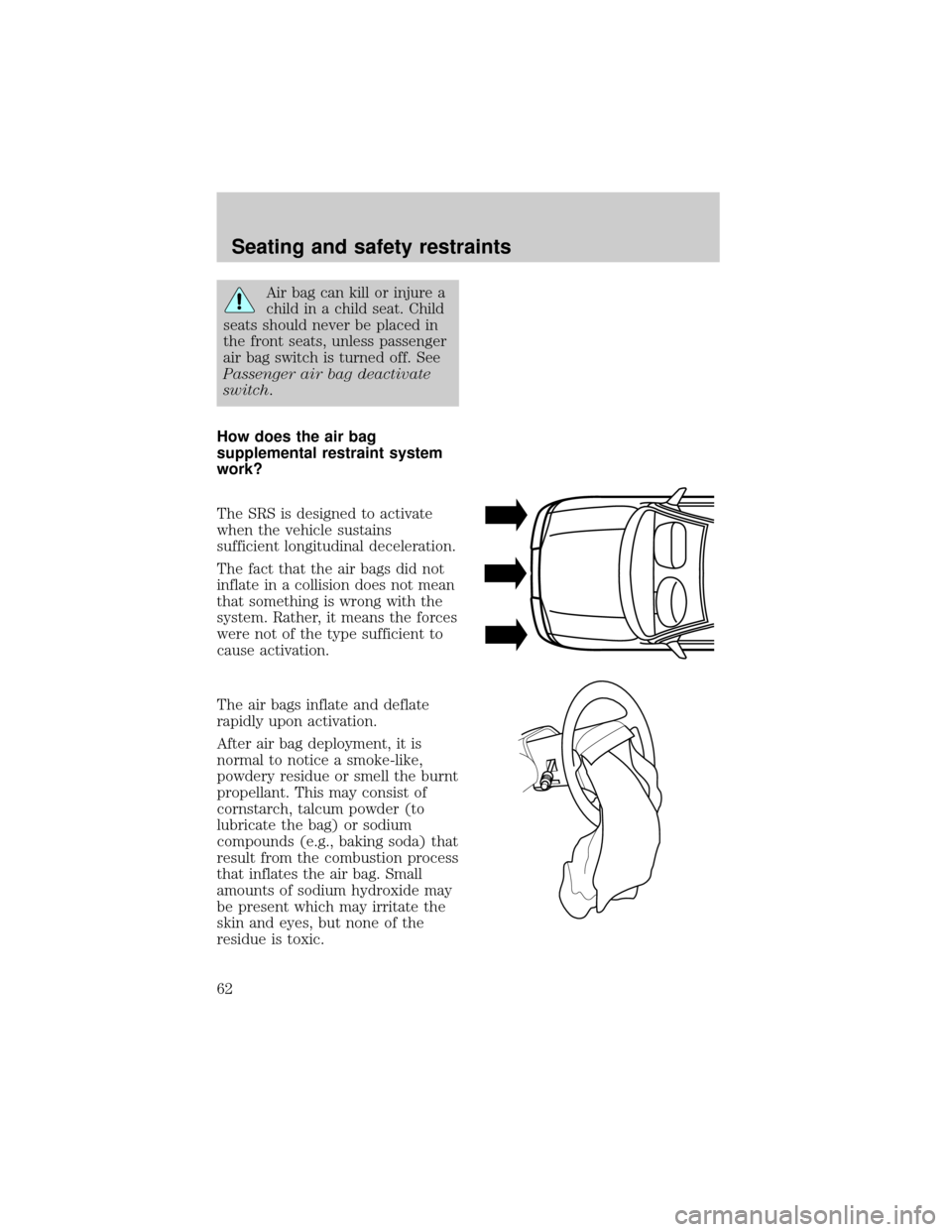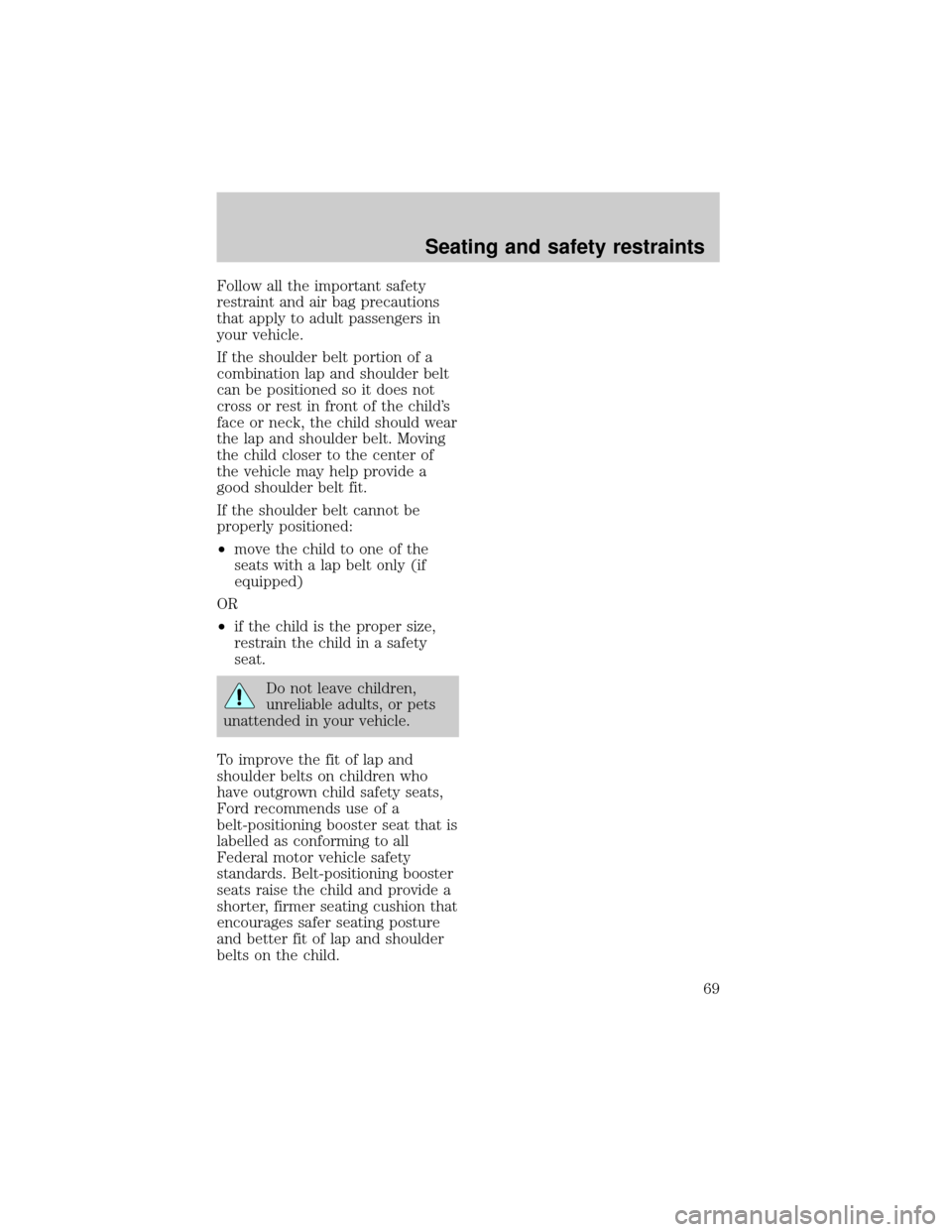Page 21 of 219
²PANEL & FLOOR-Distributes
outside air through the
instrument panel registers and
the floor ducts.
²FLOOR-Allows for maximum
heating. Distributes outside air
through the floor ducts.
²FLOOR & DEF-Distributes
outside air through the floor
ducts and the windshield
defroster ducts.
²DEF
-Distributes outside air
through the windshield defroster
ducts. It can be used to clear ice
or fog from the windshield.
Operating tips
²In humid weather, select
before driving. This will
help to prevent your windshield
from fogging. After a few
minutes, select any desired
position.
²To prevent humidity buildup
inside the vehicle, don't drive
with the climate control system
in the OFF position.
²Don't put objects under the
front seat that will interfere with
the airflow to the back seats (if
equipped).
Controls and features
21
Page 26 of 219
Operating tips
²In humid weather, select DEF
before driving. This will
prevent your windshield from
fogging. After a few minutes,
select any desired position.
²To prevent humidity buildup
inside the vehicle, don't drive
with the climate control system
in the OFF position.
²Don't put objects under the
front seat that will interfere with
the airflow to the back seats (if
eqipped).
²Remove any snow, ice or leaves
from the air intake area (at the
bottom of the windshield under
the hood).
²If your vehicle has been parked
with the windows closed during
hot weather, the air conditioner
will do a much faster job of
cooling if you drive for two or
three minutes with the windows
open. This will force most of the
hot, stale air out of the vehicle.
Then operate your air
conditioner as you would
normally.
²When placing objects on top of
your instrument panel, be
careful to not place them over
the defroster outlets. These
objects can block airflow and
Controls and features
26
Page 51 of 219
60/40 Split Rear Seat
(if equipped)
When folded down, the rear seats
provide a ªload floorº for additional
storage space. To fold down the
rear seats:
²Pull the straps to lower the seat
cushions.
²Store the center safety belt in
the opening on the seat back.
When returning the seats to their
normal position:
²Clear the load floor before
folding the seat up.
²Make sure the seat cushion is
latched into place.
²Remove the center safety belt
from its stowed position.
Check to assure that 60/40
Split rear seat cushion is
latched by pulling up and
forward on lap belt buckles.
SAFETY RESTRAINTS
Safety restraints precautions
Always drive and ride with
your seatback upright and
the lap belt snug and low across
the hips.
Seating and safety restraints
51
Page 52 of 219
To prevent the risk of
injury, make sure children
sit where they can be properly
restrained.
Never let a passenger hold
a child on his or her lap
while the vehicle is moving. The
passenger cannot protect the
child from injury in a collision.
All occupants of the
vehicle, including the
driver, should always wear their
safety belts.
It is extremely dangerous
to ride in a cargo area,
inside or outside of a vehicle. In
a collision, people riding in these
areas are more likely to be
seriously injured or killed. Do not
allow people to ride in any area
of your vehicle that is not
equipped with seats and safety
belts. Be sure everyone in your
vehicle is in a seat and using a
safety belt properly.
Seating and safety restraints
52
Page 55 of 219
²Anytimea child safety seat is
installed in the vehicle. Refer to
Safety Restraints for Children
orSafety Seats for Children
later in this chapter.
How to use the automatic
locking mode
²Buckle the combination lap and
shoulder belt.
²Grasp the shoulder portion and
pull downward until the entire
belt is extracted.
²Allow the belt to retract. As the
belt retracts, you will hear a
clicking sound. This indicates
the safety belt is now in the
automatic locking mode.
Seating and safety restraints
55
Page 62 of 219

Air bag can kill or injure a
child in a child seat. Child
seats should never be placed in
the front seats, unless passenger
air bag switch is turned off. See
Passenger air bag deactivate
switch.
How does the air bag
supplemental restraint system
work?
The SRS is designed to activate
when the vehicle sustains
sufficient longitudinal deceleration.
The fact that the air bags did not
inflate in a collision does not mean
that something is wrong with the
system. Rather, it means the forces
were not of the type sufficient to
cause activation.
The air bags inflate and deflate
rapidly upon activation.
After air bag deployment, it is
normal to notice a smoke-like,
powdery residue or smell the burnt
propellant. This may consist of
cornstarch, talcum powder (to
lubricate the bag) or sodium
compounds (e.g., baking soda) that
result from the combustion process
that inflates the air bag. Small
amounts of sodium hydroxide may
be present which may irritate the
skin and eyes, but none of the
residue is toxic.
Seating and safety restraints
62
Page 68 of 219

SAFETY RESTRAINTS FOR
CHILDREN
Important child restraint
precautions
You are required by law to use
safety restraints for children in the
U.S. and Canada. If small children
ride in your vehicle (generally
children who are four years old or
younger and who weigh 18 kg [40
lbs] or less), you must put them in
safety seats made especially for
children. Check your local and
state or provincial laws for specific
requirements regarding the safety
of children in your vehicle.
Never let a passenger hold
a child on his or her lap
while the vehicle is moving. The
passenger cannot protect the
child from injury in a collision.
Always follow the instructions and
warnings that come with any infant
or child restraint you might use.
When possible, place children in
the rear seat of your vehicle.
Accident statistics suggest that
children are safer when properly
restrained in the rear seating
positions than in the front seating
position.
Children and safety belts
Children who are too large for
child safety seats (as specified by
your child safety seat
manufacturer) should always wear
safety belts.
Seating and safety restraints
68
Page 69 of 219

Follow all the important safety
restraint and air bag precautions
that apply to adult passengers in
your vehicle.
If the shoulder belt portion of a
combination lap and shoulder belt
can be positioned so it does not
cross or rest in front of the child's
face or neck, the child should wear
the lap and shoulder belt. Moving
the child closer to the center of
the vehicle may help provide a
good shoulder belt fit.
If the shoulder belt cannot be
properly positioned:
²move the child to one of the
seats with a lap belt only (if
equipped)
OR
²if the child is the proper size,
restrain the child in a safety
seat.
Do not leave children,
unreliable adults, or pets
unattended in your vehicle.
To improve the fit of lap and
shoulder belts on children who
have outgrown child safety seats,
Ford recommends use of a
belt-positioning booster seat that is
labelled as conforming to all
Federal motor vehicle safety
standards. Belt-positioning booster
seats raise the child and provide a
shorter, firmer seating cushion that
encourages safer seating posture
and better fit of lap and shoulder
belts on the child.
Seating and safety restraints
69